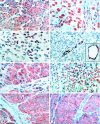Importance of vascular phenotype by basic fibroblast growth factor, and influence of the angiogenic factors basic fibroblast growth factor/fibroblast growth factor receptor-1 and ephrin-A1/EphA2 on melanoma progression
- PMID: 11891198
- PMCID: PMC1867162
- DOI: 10.1016/S0002-9440(10)64922-X
Importance of vascular phenotype by basic fibroblast growth factor, and influence of the angiogenic factors basic fibroblast growth factor/fibroblast growth factor receptor-1 and ephrin-A1/EphA2 on melanoma progression
Abstract
The expression of several angiogenic factors and receptors was examined in a series of vertical growth phase cutaneous melanomas using high-throughput tissue microarray technology and immunohistochemistry. The results were correlated with microvessel density, clinicopathological features, and patient survival. Expression of basic fibroblast growth factor (bFGF) was significantly associated with increased microvessel density. Also, we found an independent prognostic importance of vascular phenotype by endothelial cell expression of bFGF; cases with positive vessels had the best prognosis and these tumors revealed a low frequency of vascular invasion (14%) when compared with bFGF-negative vessels (47%). This bFGF-negative phenotype was significantly increased in metastatic lesions. Strong tumor cell expression of FLT-4, ephrin-A1, and EphA2 was associated with increased melanoma thickness, and ephrin-A1 staining was related to decreased survival (P = 0.039). Expression of EphA2 in tumor cells was associated with increased tumor cell proliferation (Ki-67 positivity), indicating possible autocrine growth stimulation. Thus, our findings indicate the presence of phenotypic diversity among tumor-associated vessels, and subgroups defined by bFGF expression may be of clinical importance. bFGF was associated with microvessel density, whereas the ephrin-A1/EphA2 pathway might also be important for tumor cell proliferation and patient survival.
Figures



References
-
- Folkman J: Angiogenesis in cancer, vascular, rheumatoid and other disease. Nat Med 1995, 1:27-31 - PubMed
-
- Hanahan D, Folkman J: Patterns and emerging mechanisms of the angiogenic switch during tumorigenesis. Cell 1996, 86:353-364 - PubMed
-
- Fidler IJ: Angiogenesis and cancer metastasis. Cancer J Sci Am 2000, 6(Suppl 2):S134-S141 - PubMed
-
- Ferrara N, Alitalo K: Clinical applications of angiogenic growth factors and their inhibitors. Nat Med 1999, 5:1359-1364 - PubMed
-
- Burke PA, DeNardo SJ: Antiangiogenic agents and their promising potential in combined therapy. Crit Rev Oncol Hematol 2001, 39:155-171 - PubMed
Publication types
MeSH terms
Substances
LinkOut - more resources
Full Text Sources
Other Literature Sources
Medical
Molecular Biology Databases
Miscellaneous

